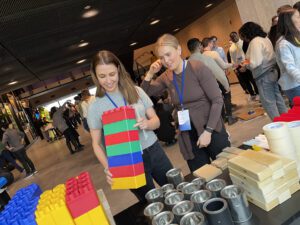A study from the University of California, Irvine, revealed that it takes an average of 23 minutes and 15 seconds to refocus after an interruption at work. That means every Slack notification, surprise meeting invitation, and innocent drop-in from one desk to another costs your team genuine productivity.
In a work culture obsessed with multitasking, companies have intentionally created environments that rob us of our most valuable currency: focus time.
This isn’t about finishing a to-do list. True focus work, the kind that fuels innovation, problem-solving, and deep thinking, can only thrive when distractions are minimized, and the brain has room to operate without disruption. The good news is that you don’t need to build a soundproof cubicle or ban email to reclaim focus time.
By intentionally creating focus periods in the workday, companies can protect attention spans, improve positive team morale, and boost productivity across the boardroom.
Boost Focus Productivity with Clear Boundaries and Structure
Most professionals struggle with structure, not motivation. When your calendar is booked solid and your inbox never stops dinging, even the most disciplined employees find it challenging to protect meaningful focus time. That’s why the foundation of focus productivity starts with clear boundaries.
Here’s what that can look like in action:
- Designate company-wide daily or weekly focus periods where no meetings, calls, or interruptions are allowed.
- Encourage employees to set their own “do not disturb” blocks on shared calendars, signaling when they’re doing deep work.
- Use tools like time-blocking, the Pomodoro technique, or focus apps to give structure and rhythm to a workday.
When teams respect these boundaries, everyone benefits. Employees aren’t just focused on work; they produce higher-quality outcomes with less mental fatigue.
Communicating effectively includes setting expectations around availability and focus. Letting your team know when you’re unavailable for non-urgent matters is respectful while setting a company cultural tone that values productivity over accessibility.
Focus on Work, Not Distractions: Building a Productive Environment
If distractions had a job description, it would read: “Specialist in stealing focus and sabotaging productivity.”
Between email pings, chat messages, and impromptu meetings, focused work can begin feeling like a rare luxury. However, creating a productive environment means helping employees focus on work by designing physical, digital, and cultural spaces to support concentration and minimize interruptions.
- Design distraction-free zones. Dedicate quiet spaces or rooms where employees can retreat for uninterrupted focus time. Make it clear that these are “heads-down” spaces—no casual conversations, phones, or surprise pop-ins.
- Clarify availability expectations. Setting expectations and letting team members know when someone is unavailable for communication reinforces a culture that respects hard work and focus time.
- Encourage autonomy and emotional awareness. Trusting employees to manage their time, energy, and effort fosters responsibility, reliability, and appreciation. Recognizing and respecting emotional intelligence in the workplace is essential to long-term focus.
When the workplace supports focus periods, team members think more creatively while individually and collaboratively solving business problems and achieving work they can be proud of.
How to Stay Focused and Productive at Work
Sometimes, staying productive in a busy workplace is like trying to read a novel in a room full of mischievous toddlers. Every distraction can derail your thought process, making it harder to accomplish anything meaningful. Fortunately, a few simple strategies can help employees learn to stay focused and productive, even in less-than-ideal conditions.
Start with structure. Time-blocking your day creates visual accountability and allocates energy efficiently. Schedule demanding focus work during peak energy hours, and reserve administrative tasks for low-energy periods (like midday slumps).
To stay in the zone:
- Limit multitasking. Studies show that performing multiple tasks simultaneously can reduce productivity by up to 40%. Focus on one task at a time during dedicated focus periods.
- Use the Pomodoro technique. Set a timer for 25 minutes of uninterrupted work followed by a 5-minute break. Rinse and repeat.
- Eliminate digital clutter. Silence non-essential notifications, keep tabs closed, and resist the urge to “just check one thing.”
Improving cooperation among coworkers is crucial. Effective communication begins when individuals understand and respect one another’s working styles. Let your team know when you’re in a focus period, and return the favor by not disturbing others when they’re “locked in.”
Helping Employees Stay Focused and Avoid Burnout
There’s a fine line between focus time and fizzling out. Even the most productive employees will burn out if they aren’t supported. Constant pressure to be “on” without reprieve can lead to disengagement, low morale, and high turnover rates. Fortunately, helping employees balance focused work and recovery time is simple and vital.
Here’s how employers can protect focus and well-being:
- Encourage realistic workloads. Chronic overcommitment kills focus. Ensure your team isn’t constantly juggling competing priorities without time to breathe. When workloads align with realistic capacity, employees can give their full attention to tasks at hand, leading to better results and less mental fatigue.
- Build in mental health breaks. Promote short walks, wellness challenges, or guided mindfulness sessions, like laughter yoga, to help employees rest and recharge. These low-effort, high-impact events improve clarity, regulate energy levels, and teach essential self-awareness for navigating a fast-paced, always-on environment.
- Train managers in emotional intelligence. Leaders who recognize signs of burnout can intervene early, offer flexibility, and adjust responsibilities before employees crash.
- Prevent employee burnout by design. Setting healthy boundaries and expectations, especially around accessibility and availability, helps teams maintain energy and performance.
Burnout isn’t always loud. It often shows up as disengagement, missed deadlines, or uncharacteristic silence. Build a company culture where employees feel safe to speak up and ask for space.

Why Focus Time Leads to Better Results and Less Overwhelm
There’s a reason athletes take rest days and authors need quiet rooms: humans can’t produce their best work in chaos. Implementing dedicated focus time helps employees create mental space to go deeper into a project, solution, or strategy, without bouncing between tasks. The result is less stress, better clarity, and improved outcomes for your business.
Here’s what happens when focus becomes part of your workplace culture:
- Better work quality. Fewer distractions lead to clearer thinking, more vigorous execution, and fewer mistakes.
- Faster project completion. Deep work accelerates output. What may take hours with interruptions can be done in less time with pure focus work. Employee experience expert Anais Rodriguez cited the need for work-life balance to improve productivity:
“When I meet with employees who are struggling with work-life balance and feeling burnt out, I always come from a place of, “What boundaries are you setting for yourselves? How are you managing your time?” It’s easy, especially for our creative teams to get lost in the work and they want it to be perfect. And so they may spend a lot of time on something that maybe instead of six hours, it could have just taken them two or three.”
- Greater job satisfaction. Employees feel accomplished and in control when they finish meaningful work. That’s a win for morale.
- Lower overwhelm and higher retention. Reducing task-switching fatigue creates sustainable workflows that minimize employee churn. Empowering employees to work without constant chaos is essential to boosting retention and keeping loyal workers around.
If we want people to be engaged, creative, and energized, we must give them time and space to be their best selves and do their best work.
Team Building Ideas to Reinforce Focus and Collaboration
Creating an environment that supports focus and productivity doesn’t mean becoming an office of silence and solo work. Strong collaboration and team cohesion are essential to protecting focus time. When teams work well together, there’s less miscommunication, task overlap, and unnecessary meetings.
Looking to blend focus-friendly team building activities with meaningful business training? How about silent collaboration challenges, where teams build a structure or solve a puzzle using only notes and hand signs? Something like this encourages creativity and patience while highlighting the value of uninterrupted mental processing.
You could also try time management games, where layered tasks must be completed under time pressure. These simulations force teams to prioritize, plan, and reflect on how interruptions affect performance.
Interested in goal-setting clarity? Learning workshops allow teams to define and share personal and collective objectives. This transparency cultivates mutual accountability and reinforces respect for everyone’s focus zones.
Team building activities can help reinforce focus by:
- Clarifying roles. Understanding their responsibilities and how their work fits into the larger picture eliminates confusion and streamlines group projects. Team building activities allow workplace crews to define and share how they work best, supporting aligned expectations during focus-heavy tasks.
- Improving communication. Structured exercises can help teams learn to communicate priorities and respect each other’s focus time. Hands-on collaboration can reduce information overload while strengthening trust.
- Enhancing emotional intelligence. Group activities that develop emotional awareness will help employees become more attuned to their colleagues’ mental bandwidth. Collaborative team building activities foster perspective and mutual understanding to influence protection and respect in the workplace.
When you invest in people, they show up. Our take on investing in employees hits it home: building capacity for focus and connection is one of the smartest long-term moves a business can make.
Here are a few specific team building activity ideas to consider:
The Big Picture challenges teams to paint individual canvases that come together to form one large, unified work of art (without seeing the complete image until the final reveal). It’s powerful and hands-on, encouraging teams to communicate and trust the process.
Chain Reaction is a hilarious team challenge where groups design complex Rube Goldberg-style machines to complete simple tasks, sparking creativity and laughter. Each team’s invention must link seamlessly with others, making it a fun exercise in strategy and collaboration.
The Do Good Bus is a surprise-filled volunteer adventure where teams hop aboard a bus without knowing their destination, only that they’ll be making a meaningful impact together in their community. It’s a turnkey team building experience that blends mystert, community service, connection, and joyful purpose.
Team building activities reiterate the power of focus while building stronger, more empathetic teams that know when to lean in and when to give one another space to think.
Boost Productivity with Focus Time and Team Building
Creating a workplace culture that values focus time isn’t about getting more done; it’s about helping teams work smarter, reduce stress, and accomplish meaningful outcomes. Companies can significantly boost productivity and positive morale by setting clear boundaries, encouraging deep work, and incorporating team building activities that support collaboration and focus.
Everyone wins when employees feel empowered to do their best work without constant interruptions. Are you ready to help your team sharpen their focus, communicate more effectively, and thrive together? Contact us now to explore custom team building solutions!















